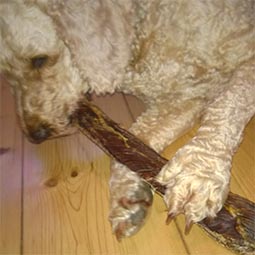Kangaroo dog treats are Hypoallergenic & very healthy for many good reasons
 Kangaroo meat and kangaroo dog treats have long been considered Hypoallergenic and this is true, there are few dogs allergic to kangaroo meat.
Kangaroo meat and kangaroo dog treats have long been considered Hypoallergenic and this is true, there are few dogs allergic to kangaroo meat.
This is why even if your dog has never tried kangaroo meat before, this high protein, low fat, Hypoallergenic dog treat can be an ideal supplement to their normal dog diet.
According to an article by the dogfoodadvisor there are several good reasons why this Hypoallergenic claim can be true in a general sense. However this kangarootreats article will explain to you why kangaroo dog treats, specifically, are likely to be Hypoallergenic for your dog.
Kangaroo is considered a ‘Novel’ dog food
When you have a dog with allergies you will most likely take your dog to a vet who will refer you to a dog nutrition or dog allergy specialist. The common initial practice will be to test their skin for reactions to common foods (meat and carbs) and if this is inclusive, they will put your dog on an exclusion diet for six to eight weeks.
During this time your dog will be exclusively fed a bland diet that has only a few natural ingredients. These ingredients will be pure meats or vegetables and will be chosen as ones that they are unlikely to have eaten before or never had reactions to before.
That is why typical meats such as kangaroo, buffalo, pheasant or salmon may be selected as the main meat source. A carb source such as millet or potato may also be added. During this time a dog should probably also have a vitamin source since whole foods will not meet aafco dog food requirements on their own. However adding anything else to the diet may cloud the results.
The fact that kangaroo meat is high on the exclusion diet list (in places where it is easily obtainable and affordable) means that in veterinary circles, kangaroo meat is believed to be very Hypoallergenic and safe for your dog. If your dog does not react during the exclusion diet, then it is likely that it was something in its diet that was causing its allergy. If it does react, then either it is the food source provided during the trial or it is likely to be an environment issue causing the allergy.
An article called ‘Food Allergies and Food Intolerance’ by Drs. Foster & Smith states that the ” most common offenders” (foods causing dog allergies) “in dogs are beef, dairy products, chicken, lamb, fish, chicken eggs, corn, wheat, and soy.”
I was personally surprised by this list as meat is an ideal thing to feed dogs (since they are mainly carnivores) however the foodadvisor explains that ” dogs aren’t naturally allergic to many of these items. It’s just that these are the ingredients most commonly used in dog food recipes.”
“food allergies account for just 10% of all canine allergies. They’re only the third most common cause — ranked well behind fleas and atopic (non-contact) allergies. ” ( Foster & Smith)
Kangaroo is the safest non allergy food you can buy
- What all of the above means is that major allergies are fairly rare in dogs.
- Of the allergies that dogs ge,t only 10% are caused by food
- Of that 10% only a small fraction are caused by the whole meats. The additives (food colourings etc) are a major cause.
The difference between food allergies and food intolerance in dogs
“A food allergy occurs when a dog’s immune system mistakenly identifies a particular food ingredient as harmful.” The body then creates antibodies to fight the specific food causing inflammation and itchiness on the body.
A severe example of this in humans is reactions to shell fish or peanuts causing an serious anaphylactic shock.
Food allergies can sometimes be suspected where the culprit is a particular kind of grass. For instance my dog was very sensitive to rye grasses and because we could not avoid them on daily dog walks we realised that increasing his Omega 3 and 6 intake resolved the majority of the skin allergy issues.
food intolerance “ is a digestive problem rather than an immune response. An intolerance occurs when a dog’s digestive system is unable to digest a specific ingredient.” You will find that almost every dog and cat are allergic to lactose (the sugar) in cow’s milk, so they will at least have runny noses if not vomiting.
The typical symptoms associated with food intolerance are: skin rash, hives, itching, paw biting, obsessive licking bloating, nausea.
Why initial eating of a new food may cause intestinal upsets
You might think by switching your dog to a low allergy meat or food might be the ideal solution, but be concerned when initially you see bloating or lots of stomach gurgling.
In the context of the above information you might immediately consider that you have observed an allergic reaction rather than decreased the odds, however the opposite is true.
You will find various sites that state such information as ” Processed pet foods contain addictive ingredients to cover up the taste of the poor quality ingredients. Addictive ingredients can include MSG (listed as hydrolyzed protein), table sugar, table salt, sweet tasting propylene glycol (a derivative of antifreeze), and other spices and chemicals. ”
More than that, science papers have been written to uncover why many kibble companies tell owners of new puppies that you MUST keep your dog on their brand of kibble for at least the first year of their life for wellbeing.
It turns out that if you reduce taste exposure of foods of your dog in the first year of its life, it will create a very narrow pallet of things the dog finds attractive to eat (called food palatability) and the dog will really struggle with trying new foods, even the healthiest things in the world like fresh raw meat.
Grains in most dog foods are crushed, cooked at high temperature then sprayed with oil (often sugar is added) to make something that a dog would never eat, all of a sudden extremely attractive.
The upshot of all of this is that some dogs will find it initially difficult to eat the things they evolved to eat such as prey meat.
If your dog initially struggles with eating kangaroo meat dog treats it is likely that it is this pallet training mechanism that you are encountering, not because the dog ‘doesn’t like’ meat or kangaroo. Even if it has had kangaroo dog food, you may find that the 20% wet weight of the roo is so small compared to the 100% dry weight of kangaroo jerky, that they have never really experience the meat properly before.
As for any change in diet, a dog may take up to a week of slow introduction of a dog treat for its digestive system to work out how to properly extract the amazingly good protein and fats from the kangaroo meat.
Another good idea is to give the dog dried kangaroo treats either after a big off lead run in the morning or at night time after they have eaten their meal. An ideal method is to wait a few hours after they have eaten their evening meal and when you are sitting down with a snack, see if they want the roo treat then.
CONCLUSION
It is very rare for a dog not to like kangaroo dog treats, once they have been given the chance to ‘acclimatise’ to the new taste and smell of the meat.
It is even rarer for a dog to be allergic to kangaroo meat, since it is used in many vet exclusion diets.
Elsewhere on this site you will see articles referring to scientific papers about the benefits of kangaroo nutrition in regards to their excellent proteins and fats.
If you want to treat your dog to a ‘novel’ meat, that is hypoallergenic and incredibly good for them, then I suggest you have a look at kangaroo meat, and kangaroo dog treats.



itstitle
excerptsa
buying itraconazole without a rx
order itraconazole generic uk